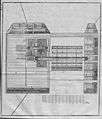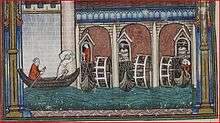Ship mill
A ship mill is a type of watermill. The milling and grinding technology and the drive (waterwheel) are built on a floating platform on this type of mill.[1] Its first recorded use dates back to mid-6th century AD Italy.[2]
Technology
Between barge and boat well is the undershot water wheel, which is driven by the flowing water of the current. There is also evidence of water mills for which both sides had a narrower water wheel, similar to an old paddle steamer. The floating platform is anchored at the most intense point in the current, to the bridge piers for easy access to the mill, or to the shore.
Floating allows the mill to operate with the same power despite changing water levels. The efficiency of the mill can at best match a standard undershot mill. Ship mills could potentially run full-time, good for tasks that demanded constant power.
Ship mills could be drawn when needed (due to shipping, rafting, ice) to shore. In central Europe ship mills were, as most water and wind mills, owned by lords or monasteries. Ship mills in Central Europe have not remained; after the advent of riverboat traffic, they became a hindrance. Ship mills last about fifty years.
 A ship mill (drawing 1 after H.Ernst, 1805).
A ship mill (drawing 1 after H.Ernst, 1805). A ship mill (drawing 2 after H.Ernst, 1805).
A ship mill (drawing 2 after H.Ernst, 1805).
History
There is historical evidence that the development of this type of mill dates back to the ingenious invention of Vitruvius, a Roman engineer of the 1st century BC. Vitruvius described a ship odometer working with a waterwheel attached to the ship hull.
In the 537 siege of Rome, supplies were interrupted by the Goths from providing the population with vital flour from the surrounding water mills. Also, the aqueducts that supplied Rome with water and some cities which had water-driven mills could no longer work. The solution devised by the Eastern Roman general Belisarius was the "reverse principle of a water mill" - the ship mills, which were anchored on the Tiber river around Rome.[2]
It was a type of watermill powered by water wheels mounted on the sides of ships moored in midstream, preferably close to bridges where the current is stronger. From then on, the ship mill spread throughout medieval Europe, reaching Paris (556) Geneva (563) and Dijon (c. 575) in quick succession.[3] They remained a common sight in much of Europe until the 19th century, with a few of them surviving up to our time.[4]
By the 10th century, the medieval ship mill had spread east to the Islamic world.[3][4] It was employed along the Tigris at Mosul in 10th-century Iraq, where large ship mills made of wood and iron could produce 10 tons of flour from corn every day for the granary in Baghdad.[5] In 1184, Ibn Jubayr described ship mills in the same region on the Khabur River.[5] From the lack of records, it appears that they did not spread further to Iran.[6]
The German terms "Schiffsmühle" and "Schiffmühle" are not clearly defined and in the literature are typically used twice. Both names are equivalent to coexist, but in the south-German and Alps areas, the first spelling ("Schiffs-") for "ship mill" is used.
Geographical spread of ship mills

Ship mills were used on most major rivers in Europe.
- Elbe - until 1911
- Rhine: Strasbourg and Mainz - 9th–12th centuriesy
- Danube: Regensburg - 1493 mentioned; Vienna at Kaisermühlen (Old Danube), or Orth an der Donau (in Lower Austria)
- Mur River: Austria, Slovenia, Croatia and Hungary
- Weser: Minden - 1326 first mentioned
- Tiber: Rome
- Seine river: Paris, near or under the bridges
- Marne river, Garonne river, Loire river, in France, until 1850
- Kura river: Tbilisi, since at least the 10th century until 1920-30s.
Tourism
There are some replicas of ship mills:
- working ship mill on the Weser river, in Minden (North Rhine-Westphalia, Germany,
- ship mill on the Mulde river, in Höfgen, Saxony, Germany, in the hollow, since 1992 all year on the river, the water is pumped,
- working ship mill on the Danube, in Orth an der Donau, Austria,
- working ship mill on the Danube, in Ráckeve, Hungary,
- ship mill on the Mur river, in Mureck, Styria, Austria,
- ship mill on the Mur river, in Verzej, Slovenia
- ship mill on the Mur river, in Sveti Martin na Muri, Croatia.
There are also ship mills on land, as monuments:
- In Magdeburg (Germany), on the banks of the Elbe. There were once up to 23 pieces.
- In Bad Düben (Germany) in the castle grounds, there is the mountain ship mill, formerly with the grain as crushed.
Photo galleries
- Deutsche Fotothek-Dresden - model of a ship mill formerly in Pieschen.
- Boat mills: water powered, floating factories, article in the Low-tech Magazine
Notes
- ↑ "Deutsches Museum: Ship Mill", The Deutsches Museum's collections: Ship Mill (Model), 1819 (see below: External links).
- 1 2 Wikander 2000, p. 383
- 1 2 Wikander 2000, p. 384
- 1 2 Forbes 1965, pp. 105f.
- 1 2 Hill 1984, p. 137
- ↑ Harverson 1993, p. 176, fn. 31
References
- Forbes, R. J. (1965), Studies in Ancient Technology, 2 (2nd ed.), Leiden: E. J. Brill, pp. 105f.
- Harverson, Michael (1993), "Watermills in Iran", Iran, 31: 149–177, doi:10.2307/4299897
- "Deutsches Museum: Ship Mill", The Deutsches Museum's collections: Ship Mill (Model), 1819 (see below: External links).
- Heinrich Ernst: Anweisung zum praktischen Mühlenbau. Leipzig 1805.
- Hill, Donald (1984), "Information on Engineering in the Works of Muslim Geographers", History of Technology, 9: 127–142
- Daniela Gräf, "Boat Mills in Europe from Medieval to Modern Times". Veröffentlichungen des Landesamtes für Archäologie, Sachsen 51, 2006.
- J. Mager, G. Meißner, W. Orf: Die Kulturgeschichte der Mühlen ("The Cultural History of Mills"), Leipzig 1988.
- Adam Meltzer: Mühlenbaukunst ("Mill Architecture"), Merseburg 1805.
- "Wien - 22. Bezirk/Donaustadt", Wien.gv.at, 2008, webpage (15 subpages): Wien.gv.at-donaustadt (in German).
- Wikander, Örjan (2000), "The Water-Mill", in Wikander, Örjan, Handbook of Ancient Water Technology, Technology and Change in History, 2, Leiden: Brill, pp. 371–400, ISBN 90-04-11123-9
External links
| Wikimedia Commons has media related to Shipmills. |
- Historische Schiffsmühle, Magdeburg (Sachsen-Anhalt/Germany ...Historical ship mill, Magdeburg (Saxony-Anhalt/Germany) - photos and videos tagged with ship mill, webpage: flickr.com-9676.
- "Deutsches Museum: Ship Mill", The Deutsches Museum's collections: Ship Mill (Model), 1819, webpage: mill/ deutsches-museum.de-ship-mill (English).
German webpages
- www.schiffmuehle.de Die Schiffmühle in Minden.
- www.schiffsmuehle.at Die Murecker Schiffsmühle auf der Mur.
- www.schiffmuehle.at Die Schiffmühle in Orth.
- www.duebener-heide.de/heimatverein/schiffm.html Bergschiffmühle in Bad Düben.
- www.deutsche-muehlen.de DGM.
- www.fan-nds.de Archäologische Funde.
- Schiffmühle in Slowakia Die Schiffsmühle in Kolarovo.
- www.earthlights.de-minden Image gallery of ship mill in Minden.

.jpg)



